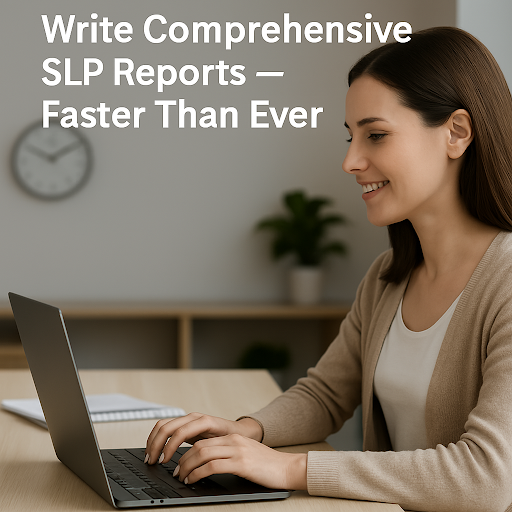How to Write a Comprehensive SLP Evaluation Report Faster
Smart strategies to write clear, thorough reports without the overwhelm

Speech-language pathologists are experts at identifying and diagnosing communication challenges — but writing the evaluation report afterward?
✅ That's often the part that feels overwhelming.
Between scoring assessments, interpreting results, summarizing background information, and crafting recommendations, the evaluation report can eat up hours of precious time.
The good news?
✅ With a few smart strategies (and a little automation), you can write clear, comprehensive reports much faster — without sacrificing quality.
Here's how.
1. Start With a Clear Template
Every evaluation should follow a consistent structure.✅ Having a reliable template saves you from reinventing the wheel every time you sit down to write.
Your template should include:
- Background and reason for referral
- Assessment procedures
- Behavioral observations
- Test results and interpretation
- Summary and recommendations
Pro Tip:✅ Customize your template slightly depending on your setting (e.g., schools vs. private practice) so you don't waste time adjusting formatting every time.
2. Use Automated Scoring Tools
Manually scoring assessments slows you down and leaves room for error.
Instead, use a tool like SLP Score to automate:
- Raw score entry
- Standard scores, percentile ranks, and age equivalents
- Confidence intervals and scoring ranges
Automation saves time, reduces mistakes, and gives you a polished data set to plug straight into your report.
3. Pre-Write Standard Interpretation Phrases
There are certain phrases you end up writing again and again, like:
- "Scores within the average range suggest typical language development."
- "Below-average performance on expressive language tasks indicates..."
Rather than writing them fresh each time, save your go-to phrases in a "Clinical Language Bank" you can copy and tweak as needed.
Pro Tip:✅ SLP Score provides initial interpretations you can edit, so you're never starting from a blank page.
4. Summarize Key Patterns Early
As you review assessment data, jot down 2–3 key patterns before you start writing.
For example:
- "Expressive language significantly weaker than receptive language."
- "Significant difficulty with articulation of later-developing sounds."
Having these patterns identified early makes it much faster to write your Interpretation and Summary sections because you already know what story the data is telling.
5. Dictate, Then Edit
Sometimes typing slows you down more than you realize.
Try dictating your first draft using a voice-to-text tool.✅ Focus on getting your thoughts out quickly, then edit for clarity later.
This method helps you avoid overthinking sentence structure during your first pass.
6. Automate the First Draft
Tools like SLP Score can take your assessment results and generate a first draft of your evaluation report.
Instead of starting from scratch, you're editing a solid draft that's already:
- Scored
- Interpreted
- Organized
You stay in full control of the final product — but you skip the most exhausting steps.
Conclusion: Work Smarter, Not Harder
Writing high-quality SLP evaluation reports doesn't have to be a marathon.✅ By building smart systems, using automation, and cutting out repetitive tasks, you can save hours every single week.
Ready to speed up your evaluations even more?
✅ Try SLP Score today and see how much easier report writing can be.
Ready to Streamline Your Report Writing Process?
SLP Score can help you write comprehensive reports faster with automated scoring and first drafts.
Try SLP Score Free